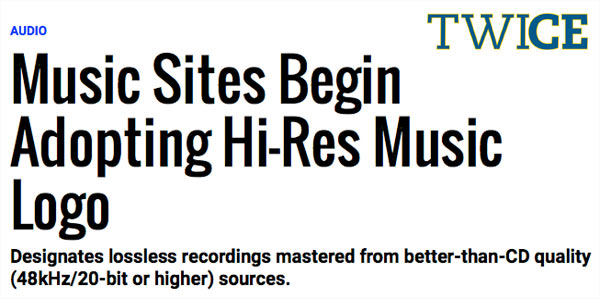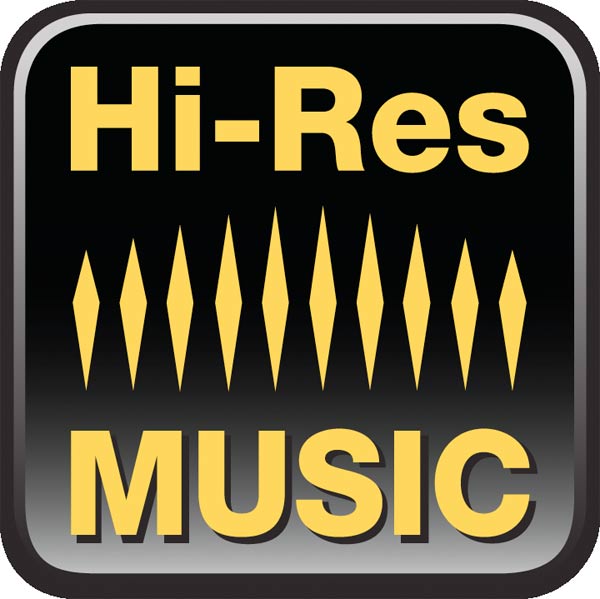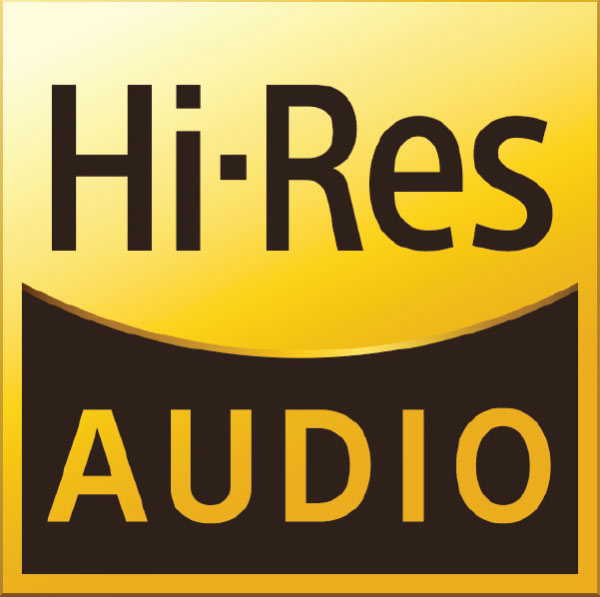Hi-Res Download Sites Begin Adopting Hi-Res Music Logo
The continuing confusion over which terminology and logo to use when referring to the emergence of the “hi-res” market received a little clarity this week as reported by Twice’s website. Joseph Palenchar posted an article about the adoption of the Hi-Res Music logo by a number of the largest “hi-res” music sites including Acoustic Sounds Super HiRez, Blue Coast Music, HDtracks, IsoMike Recordings, ClassicsOnline HD*LL (operated by the Naxos Group of Companies), PonoMusic, and ProStudioMasters.
Figure 1 – The new Hi-Res Music logo. Any digital transfer of an old analog master or new production done at 48 kHz/20-bits qualifies. It is even possible to apply this logo to a CD that gets upconverted to 96 kHz/24-bits or higher.
I took a brief trip to several of these sites and didn’t manage to find the logo. It seems the process is just beginning to happen. I should mention that I wasn’t contacted by the people behind this effort with regards to using the logo on iTrax. iTrax, the first high-resolution download site in this country and the only one that actually offers exclusively high-resolution content, isn’t among the major sites listed above because I haven’t entered into licensing agreements with the major music labels. The content on my site is limited to new recordings done with high-resolution capable equipment. iTrax offers the real thing.
Marc Finer of the Digital Entertainment Group rolled out the logo at the CE Week events back in June of this year during a presentation. The Twice article credits the development of the logo to the Recording Industry Association of America (RIAA), the trade group that represents the major record labels.
Figure 2 – The original Hi-Res Audio logo, which is restricted to hardware.
As for the reasons why another logo was deemed necessary after the JAS “Hi-Res Audio” logo was already well established, I don’t find the explanation provided by the reasons mentioned in the article plausible. According to Joe Palenchar:
“The Hi-Res Music logo, unveiled in June, was created at the request of Sony Music Entertainment, Universal Music Group and Warner Music Group to help consumers find high-resolution recordings available from digital music retailers in the U.S., Canada, and Europe for downloading or streaming. Under terms of a licensing agreement, the logo must be accompanied by the name and resolution of a song’s digital format.”
They should say “resolution of the delivery container of a song’s digital format”. The idea or provenance is critical but ignored.
If you search around the web for references to the Hi-Res Audio logo, you’ll find plenty of press releases (including some from the CEA/CTA) that make it clear that the logo applies to music as well as hardware. But the requirements for using the JAS logo are much higher than the rather weak definition for the Hi-Res Music logo. The lower standard, which is barely more than the CD spec, was described in the Twice article:
“The logo designates songs produced in lossless audio ‘capable of reproducing the full spectrum of sound from recordings which have been mastered from better than CD quality (48kHz/20-bit or higher) music sources that represent what the artists, producers and engineers originally intended’.”
This description is virtually meaningless when you think about it but it was necessary because none of the content on the sites mentioned above qualify for the “Hi-Res Audio” logo. When confronted with this obvious problem, the people and organizations punted the ball and opted to create a new term and logo to qualify their standard-res transfer for “hi-res” status. After all, there would be no “hi-res” content at all if they had to meet the higher standard.
The use of either one of these logos won’t help consumers identify the highest quality files…the myth continues. The use of the new logo is another ploy to duck and cover from the truth about so-called “high-resolution” music. As PonoMusic’s Bruce Botnick said in a interview, “it’s a case of buyer beware.” I couldn’t agree more.




Once “educated” the would be future becomes “beware” and will cling to their analog all the longer. The industry will remain as diverse as ever.
The backlash against the music industry should be about as equivalent to the Great Sony CD Root scam once consumers hear no difference on their cheap MP3 players and realize they’ve been had.
They had a fine system that started back in the 80s, the SPARS code. By adding a forth descriptor of HD to represent a digital stream of 20/48 or better we’d have a code telling us all we need to know. You could do it in a fancy colorful box to make the artful happy. All too late now I guess.
HD any where in the chain would equal a High Rez tech was used.
AAA – A fully analogue recording, from the original session to mastering. Since at least the mastering recorder must be digital to make a compact disc, this code is not applicable to CDs.[3]
AAD – Analog tape recorder used during initial recording, analog tape recorder used during mixing, digital mastering.
ADD – Analog tape recorder used during initial recording, digital tape recorder used during mixing, digital mastering.
DDD – A fully digital recording, from the original session to mastering.
DAD – Digital tape recorder used during initial recording, analog tape recorder used during mixing, digital mastering.
DDA – Digital tape recorder used during initial recording, digital tape recorder used during mixing, analogue (vinyl) mastering.
Sal, the SPARS codes were useful. I’ve written several articles and designed graphics to extend the codes for provenance. No one is interested.
Like roaches, many in the various factions of the High Fidelity industry run quickly when a light is shown that reveals the facts.
The concept of creating and marketing ‘true” Hi-Res recordings such as yours, seems to have little chance of ever going main-stream. In no order, the reasons are that people cannot usually tell any difference, it is too difficult to understand, quality reproduction equipment is costly, and most important, popular artists don’t use it. So much for the “as the artist intended” nonsense.
You, and a few others, are the disciples crying in the wilderness. You are burning, it appears, a tremendous amount of resources battling several armies at once with even small victories rare. I wonder, could your (and your followers’) goals be better met by largely ignoring the snake oil tent and simply advancing an entirely new organization. People often seem more interested in new things than yet another critique of the status-quot.
i would propose a new trade group (similar to the one which ignores you) which promotes and depicts the real-deal in hi-res sound. Design yet another “logo” conveying both the full spectrum of sound and the provenance. That shouldn’t be hard — I think the two icons you discussed look like road construction signs anyway. Adopt a motto conveying that your organization’s, publications and products are really the best recordings possible.
Of course, this will be difficult and I know nothing about the “music and artist” world to be dealt with. But I am becoming a bit bored of the theme you have had, or chosen to adopt, in pointing out the fallacies, ignorance and deliberate deceptions of the predominant players in the music world. There seems to be no end to the individuals and companies coming out of the woodwork to profit on this newest interest. But you are often preaching to the choir — your readers already understand the steps to a hi-res recording. Maybe its time to move on. Could this idea help?
I actually formed a group called the High-Definition Surround Music Group and reached out to my friends, companies, and professionals. It was a half hearted effort. Perhaps the time is right to re-energize this group or one like it. I think my next move is to work on the book and develop the database for high-res music. Build an app that will easily identify the provenance and fidelity of every track offered by the major sites. Consumers that want to know will be able to get the information.
I realize I write on the same theme too much. I’ll push to write about the positive things in the world of better audio as well. But it’s hard to find them.
Yes the time may be right. I would suggest backing off on the surround aspect, maybe including it as a wing somehow. But a new organization those mission is to reveal and support the very best in audio reproduction. Some advertising of the new organizations goals and a new logo that denotes recordings that offer those attributes would be kool. Offer the logo license to the other labels who would qualify for a HA-HA-HA logo, maybe without fee? There are a number of small labels doing true High Def recordings today.
Mark, how is an app going to do that other than the obvious stuff (look for a sharp low-pass etc.)?
There are a number of ways that an app can analyze and report on the veracity of a file being high-res or not. I’m exploring some of them…I’ll keep you posted.
Hi Mark,
In the direction of “positive things in the world of better audio”, I would like hear what you have to say about the latest developments in the world of more immersive sound for headphones. I know you are an incredibly busy guy and now facing the production of your New Book. But a blog or two devoted to the emulation of surround sound for headphones would interest a large community of music listeners. DTS – X has come out with “object audio” effects, the Smyth Realizer folk with “head tacking” strategies, the HRTF with personalized/customizable headphone audio, and Fong Audio with a kind of DSP based on specific speaker systems. I have not heard all all of these emulations, but have heard a few (actually there are very limited applications so far), and I understand that you have been exploring head phone surround sound as well. It would be instructive to hear about the various approaches being taken in this field and hear what you think the present and future might bring beyond the traditional stereo headphone.
Jack
Thanks Jack…I’m very familiar with a number of these systems and own a Smyth Realizer, which is the best of the bunch. I’ll get a post written asap.